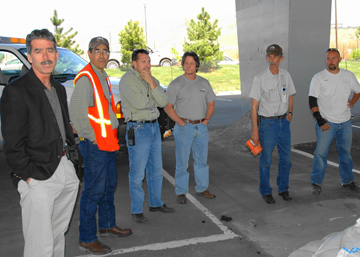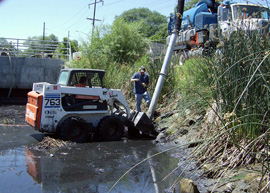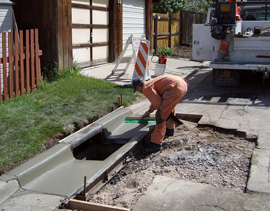Salt Lake City Stormwater Division Celebrates A Century of Service
Congratulation to the employees who manage, operate and maintain the City's stormwater and creek flow infrastructure for their outstanding service.
September 2, 2008
|
With the construction of this first stormwater conveyance facility, the City began an one-hundred year program to manage the effects of storm events and control snow-melt from the canyon streams that traversed the City enroute to the Jordan River and the Great Salt Lake.
Even through Salt Lake City receives only 16 inches of precipitation, strong rain events can cause property damaging localized flooding. Also, high spring snow-melt flows from the Wasatch Mountains have historically caused larger scale flooding events. Two such events occurred in 1952 and 1983 when the 1300 South Flood Plain was flooded and City Creek flowed out of its banks. The 1952 flood inundated over 400 city blocks; and the 1983 flood waters were contained within 1300 South and State Street. Stormwater and City Engineer employees were at the center of the '83 successful flood fight.
Today, a century later, the City's stormwater system services a modern metropolitan area. The stormwater infrastructure has grown to 288,231 linear feet of drainage pipe ranging in size from 4-inches to 144-inches. The system also consists of canals, creeks, ditches and rivers for a total of 455.25 miles of conveyance facilities. Thirty-seven stormwater detentions basins are used to capture peak flows and the stored water is released slowly back into the system to avoid localized flooding.
Twenty-five pumping stations are operated and maintained by a separate work group within the Department of Public Utilities. Supervisor Tom Tabish is responsible for both sanitary sewer and stromwater pumping facilities.
Public Utilities Director Jeff Niemeyer notes that the City has a long history of dealing with mountain snowmelt and urban run-off and in more recent times new federal regulations. As a Stromwater Utility Fund, the department has been able to implement programs necessary to comply with the Clean Water Act and make the necessary investments in infrastructure improvements to manage flood waters. “The City has received many returns for its investment in stormwater management,” said Niemeyer. “Urban drainage is a critical public service to a growing city by allowing us to meet our environmental stewardship obligations and protect both private and public property from water damage.”
Currently, the Stormwater Utility budget is $9 million with the operations budget of $3.9 million. The remainder is spread between debt service, capital equipment and capital improvements. The Utility is staffed with 26.5 full time positions for maintenance, engineering, administrative and water quality tasks.
Maintenance Supervisor E.V. Holland says he loves the work – especially the problem solving aspect. He and the other 11 team members of the maintenance division are responsible for the operation and maintenance of stormwater collection system, excluding the pumping stations, which is a key component of the stormwater program. “When it storms,
|
Holland credits system improvements and a strong maintenance programs for reducing the number of drainage problems and customer complaints. According to Holland, revenues from the Utility Fund fees has made a “substantial different” in the the Utility's ability to invest in the infrastructure and maintain the system. “There has been many system improvements over the past 20 years” says Holland. Foremost are the post 1983 record flood improvements to the stream conveyance systems, Little Dell reservoir and the 900 South stormdrain. Holland further noted that maintenance efforts are more efficient because of vacuum street sweepers and the vactor trucks, which remove the dirt and debris, rather than allowing it to reach the stormdain pipes and waterways and settle out as silt.
Small localized projects are important as well. Annually $200,000 is budgeted to improve local drainage or flood areas. “Eliminating these small nuisance problems has gone a long way towards improving the quality of life for neighborhoods,” said Holland.
Financing stormwater improvements has not always been easy. In the early years financing proved to be difficult. A $1.5 million bond election for streets and stormwater improvements failed in 1917. Money was also in short demand due to the World War I and City government spending was retrenched during this period. Likewise, during World War II there was a curtailment of construction.
A major step forward occurred in 1925 when City Engineer Sylvester Q. Cannon proposed a “Main Storm Sewer System” to relief the property owners from damages and expense resulting from stormwater run-off in the developed portions of the city. He noted that in 1913, there was practically no stormwater sewers in the City, but since that time they had been able to construct the most urgently needed conduits for the carriage of stormwater and natural streams. The proposed additions would provide a city-wide stormwater infrastructure needs. Over the following years, the City has built on City Engineer Cannon's vision for a city-wide system.
During most of the first century, the stormwater system was under the direction of the elected City Commission, and assigned to the Streets and Public Improvements Commissioner from 1912 to 1991. The City Engineer was responsible for the design and construction of the system, and employees in the Streets Department operated and maintained the system. Besides stormwater management, the Streets Department was responsible for the distribution of irrigation water to the Parley's Water Users Association.
As the open ditches were replaced with asphalted streets with curb and gutter, the irrigation water was delivered to the users via the public streets and gutters. In 1951, this responsibility was transferred from the Streets Department to the Water Department.
In 1980, the City adopted the Mayor and City Council form of government and stormwater was under the Public Services Department, Streets Division.
|
Under the Stormwater Utility Master Plan, eighty-three (83) major projects were identified and prioritized for construction in the annual budget. At the end of June 31, 2008, over $68 million in system improvements have been completed. Twenty-five percent of the annual budget expenditures is allocated to capital improvements.
Besides capital improvements to the Stormwater System, the maintenance team annually clean and inspect 8,000 inlets and junction boxes, 10 percent of main lines and 932 overhead driveways.
Partnerships with Salt Lake County for the public information program “We all live downstream,” Salt Lake City Public Services for street sweeping and Salt Lake City Parks for maintenance of the detention basin sites have resulted in cooperation and program efficiencies.
To the employees of the Stormwater Utility and all of the Utility's supporting employees, “Happy 100.”


